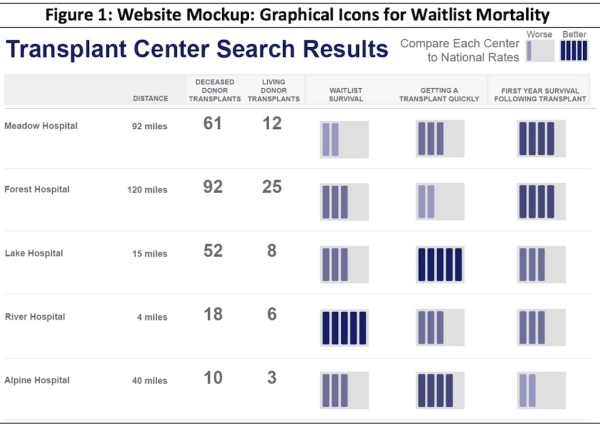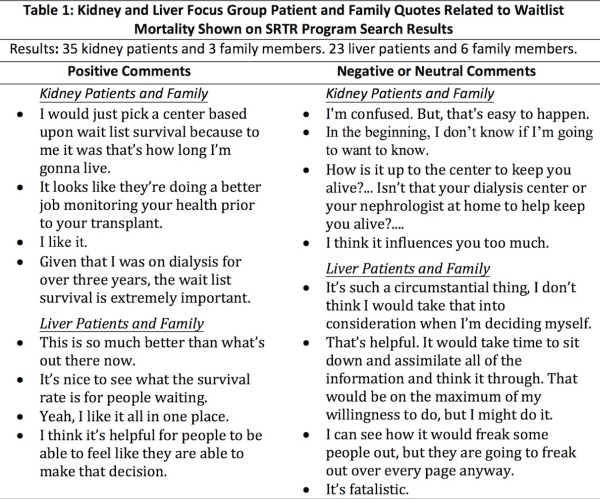Evaluating Displays of Program Waitlist Mortality on Public Search Results
1Department of Medicine, Hennepin County Medical Center (HCMC), University of Minnesota (UMN), Minneapolis, MN
2Department of Epidemiology and Community Health, UMN, Minneapolis, MN
3College of Design, UMN, Minneapolis, MN
4Scientific Registry of Transplant Recipients, Minneapolis Medial Research Foundation, Minneapolis, MN
5Department of Surgery, UMN, Minneapolis, MN
6Division of Gastroenterology, Hepatology, and Nutrition, UMN, Minneapolis, MN
7Division of Gastroenterology and Hepatology, Stanford University, Palo Alto, CA
8Division of Hepatology, University of Washington, Seattle, WA.
Meeting: 2018 American Transplant Congress
Abstract number: B323
Keywords: Patient education
Session Information
Session Name: Poster Session B: Non-Organ Specific: Economics, Public Policy, Allocation, Ethics
Session Type: Poster Session
Date: Sunday, June 3, 2018
Session Time: 6:00pm-7:00pm
 Presentation Time: 6:00pm-7:00pm
Presentation Time: 6:00pm-7:00pm
Location: Hall 4EF
The Scientific Registry of Transplant Recipients (SRTR) provides federally mandated program-specific transplant data to the public. SRTR has developed new website materials to provide more comprehensive data, including a potential 5-tier graphical icon display of waitlist mortality. Currently, there is little understanding of patient perceptions of this information. This study conducted kidney and liver focus groups for candidates and family members at one local center and national recipients from every Organ Procurement and Transplantation Network region. Each 90-minute discussion included open-ended feedback on website mockups depicting waitlist mortality and alternate metrics. Mockups used hypothetical programs with realistic data. The 13 focus groups included 67 total participants. Perceptions of waitlist mortality information were mixed. Positive comments emphasized the relevance for candidates with long waits, and negative comments discussed challenges to synthesizing all information.
The 13 focus groups included 67 total participants. Perceptions of waitlist mortality information were mixed. Positive comments emphasized the relevance for candidates with long waits, and negative comments discussed challenges to synthesizing all information. A range of positive and negative feedback suggests waitlist mortality metrics will be relevant to different patients and at different points in time.
A range of positive and negative feedback suggests waitlist mortality metrics will be relevant to different patients and at different points in time.
CITATION INFORMATION: Schaffhausen C., Bruin M., Chu S., Matas A., Lake J., Kim W., Biggins S., Snyder J., Kasiske B., Israni A. Evaluating Displays of Program Waitlist Mortality on Public Search Results Am J Transplant. 2017;17 (suppl 3).
To cite this abstract in AMA style:
Schaffhausen C, Bruin M, Chu S, Matas A, Lake J, Kim W, Biggins S, Snyder J, Kasiske B, Israni A. Evaluating Displays of Program Waitlist Mortality on Public Search Results [abstract]. https://atcmeetingabstracts.com/abstract/evaluating-displays-of-program-waitlist-mortality-on-public-search-results/. Accessed December 20, 2025.« Back to 2018 American Transplant Congress
